Webinar Transcript: Unpacking European Climate Regulations
ESG and sustainability regulations in the EU

The Corporate Sustainability Reporting Directive (CSRD) is replacing an existing regulation known as the Non-Financial Reporting Directive (NFRD) which has been in place for several years and applies to large, publicly-listed firms operating in EU.
The CSRD will be implemented to address existing concerns over the NFRD, primarily about the scope and the comparability of the NFRD to other regulations. It’s eventually going to impact close to ~50,000 firms just within Europe.
Another regulation that will come into place soon within the European Union is the Corporate Sustainability Reporting Directive (CSRD). This regulation is still being finalized but expected to be finalized in early 2024.
CSRD will apply to both EU and Non-EU firms, and it’s going to require an evaluation of various human rights, social and environmental conditions within an organization’s supply chain, with large rippling effects expected.
A few other general sustainability regulations that are already in place in the EU are the EU taxonomy and the Sustainable Finance Disclosure Regulation (SFDR). The EU Taxonomy is a classification system for economic activities created to help investors make smart decisions about how to invest in sustainable assets. The SFDR requires financial market participants like large banks and asset managers to prepare and disclose on certain sustainability related information.
Non-EU sustainability regulations

Beyond EU regulations, there have been several climate focused disclosures that have been required in the U.S and throughout the world. In the U.S. the two that are most discussed are the SEC’s proposed climate disclosure rule, and California’s climate disclosure laws.
Both the SEC and the California legislation would require firms to disclose their greenhouse gas emissions as well as certain climate-related risks. The SEC ruling has not been finalized yet but is predicted to be early 2024.
The California legislation will apply to any business, public or privately listed, that does business in California and meets certain revenue thresholds. It’s expected to take place and require reporting starting in 2026.
Looking at a more global scale, several countries that are implementing climate-based disclosures that follow the Task Force on climate-related financial disclosures requiring firms to disclose a whole variety of metrics, policies, and procedures, all relating to climate. That applies to countries like the United Kingdom, Australia, Canada, Brazil, Singapore, Japan and more. Lastly, the concept of the TNFD or the task force focuses on nature-related financial disclosures, and these are all currently voluntary. Certain countries will soon start to require specific regulations within their jurisdiction based on the TNFD.
CSRD—components and impact
CSRD at a glance
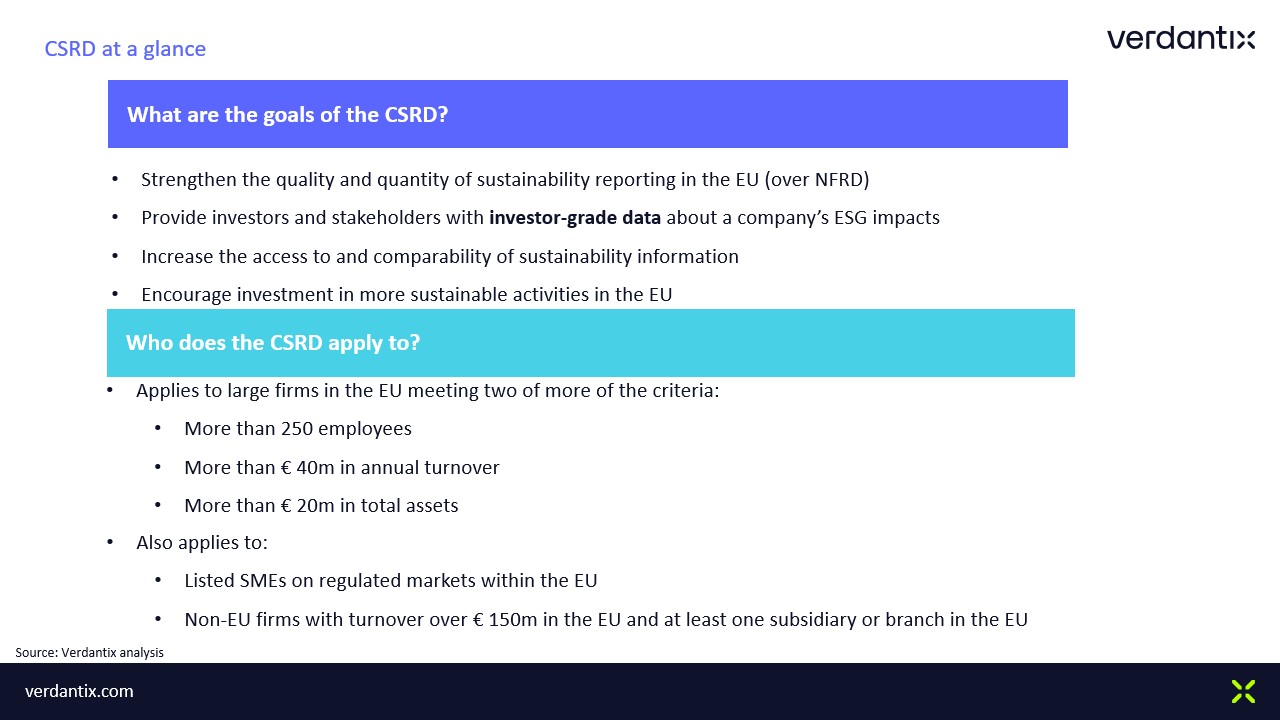
A few key challenges with CSRD are that it is a very nuanced regulation, so when looking at whether it applies to your organization, that’s an evaluation that you’ll need to do with your legal team.
The CSRD aims to strengthen the quality of sustainability reporting within the EU. It’s going to require firms to disclose investor grade data so that it’s widely accessible to a variety of stakeholders, including investors.
The CSRD was developed to help investors to use sustainability information to improve their investment decisions, taking a step beyond the NFRD. The CSRD places an emphasis on high quality investor grade data, holding sustainability data to the same standards that most companies and regulation regulators hold to their financial data. Another goal of the CSRD is to increase access to sustainability related information, and comparability of this information, both between different firms and within some of the different frameworks and other standards.
In terms of who will be subject to the CSRD, there’s several different categories of firms. Generally, it’s going to apply to all large firms in the EU that meet certain criteria related to their number of employees, annual revenue, total assets, but it’s also going to apply to small and medium size enterprises within the EU that are listed on regulated markets, as well as certain non-EU firms that have some sort of presence in the EU with and that meet certain turnover threshold. The key takeaway is that it’s going to apply to a large range of companies, both in the EU and outside of the EU. It’s not just some of the larger firms that we are used to seeing subject to these reporting requirements.
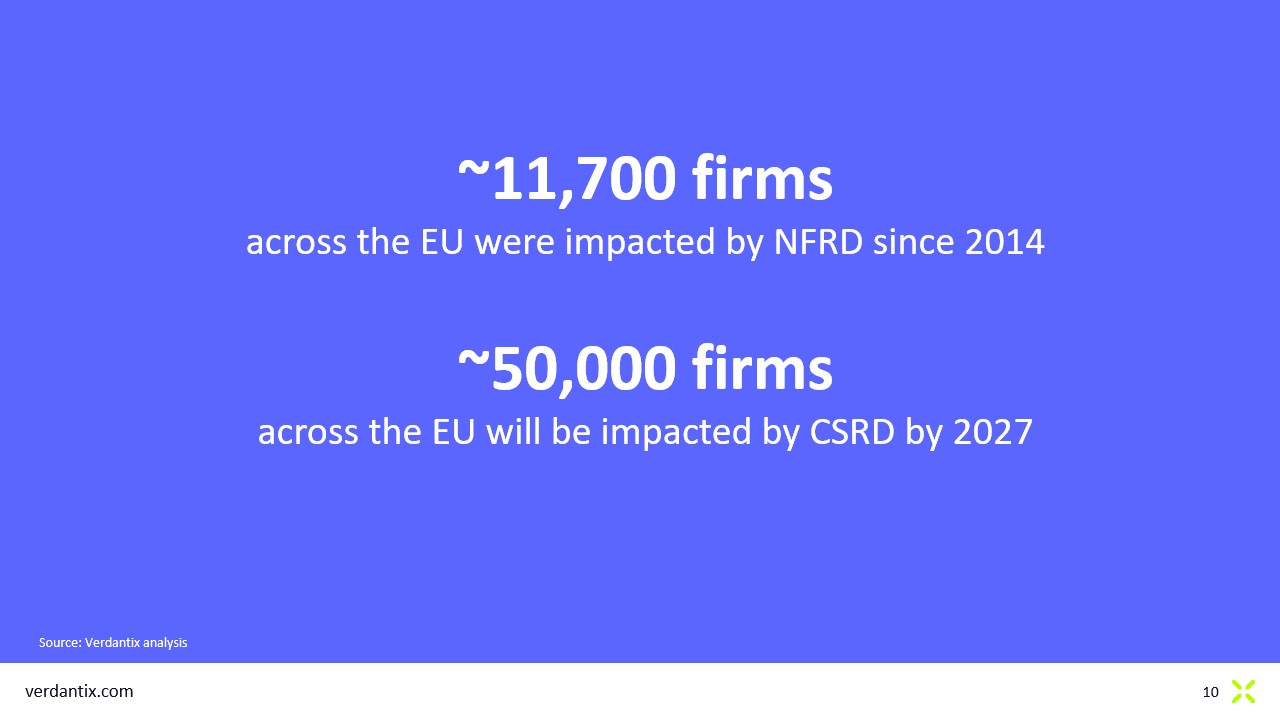
The CSRD is expected to impact ~50,000 firms just within Europe to report by 2027. That’s quite a big jump, more than tripling the number of firms that are going to be subject, and this doesn’t even account for firms outside of the EU.
Phased approach to the CSRD
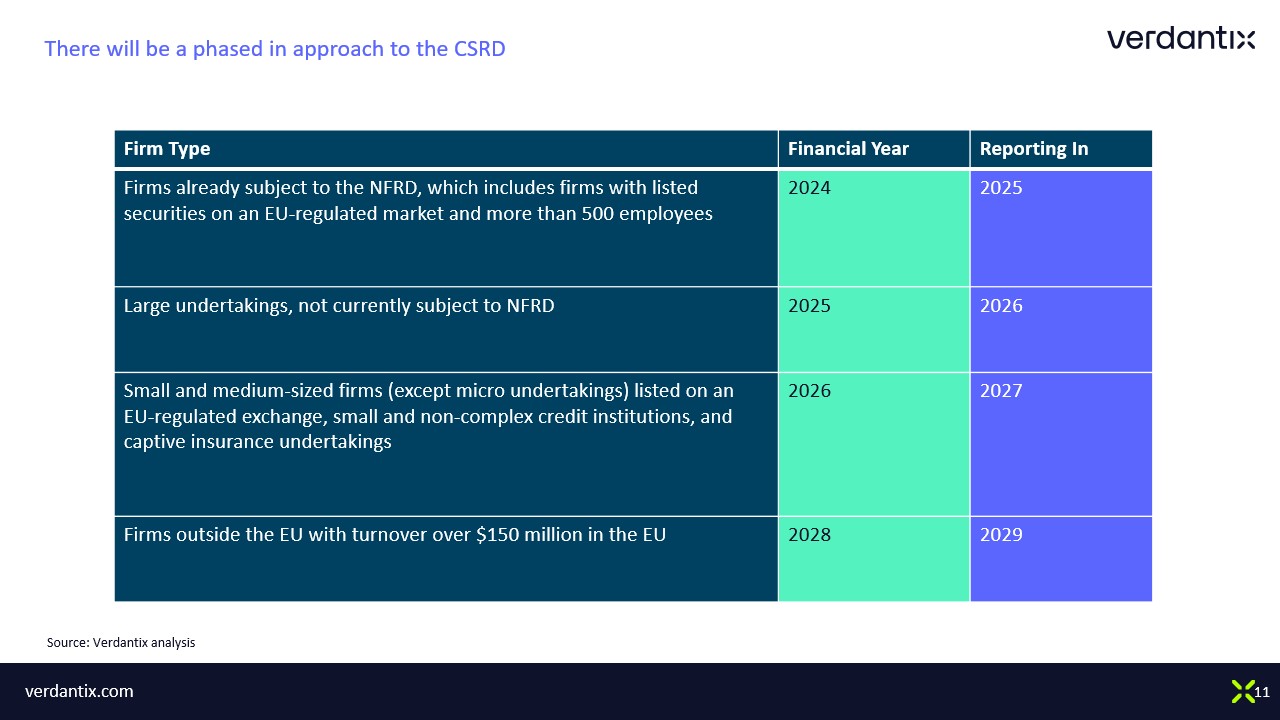
The CSRD is only coming into effect next year for those firms that are currently subject to the NFRD reporting requirements and ~11,000 firms are going to have to report in 2025 for the sustainability data that they collect in the year 2024.
Large undertakings within Europe that are not subject to the NFRD will have to report one year later than that, and small and medium sized firms are going to have to report within Europe one year after that. Reporting in 2029 for financial year 2028, that’s going to be when those ~10,000 firms outside of the EU are going to have to report in line with the CSRD.
Key components of the CSRD and challenges
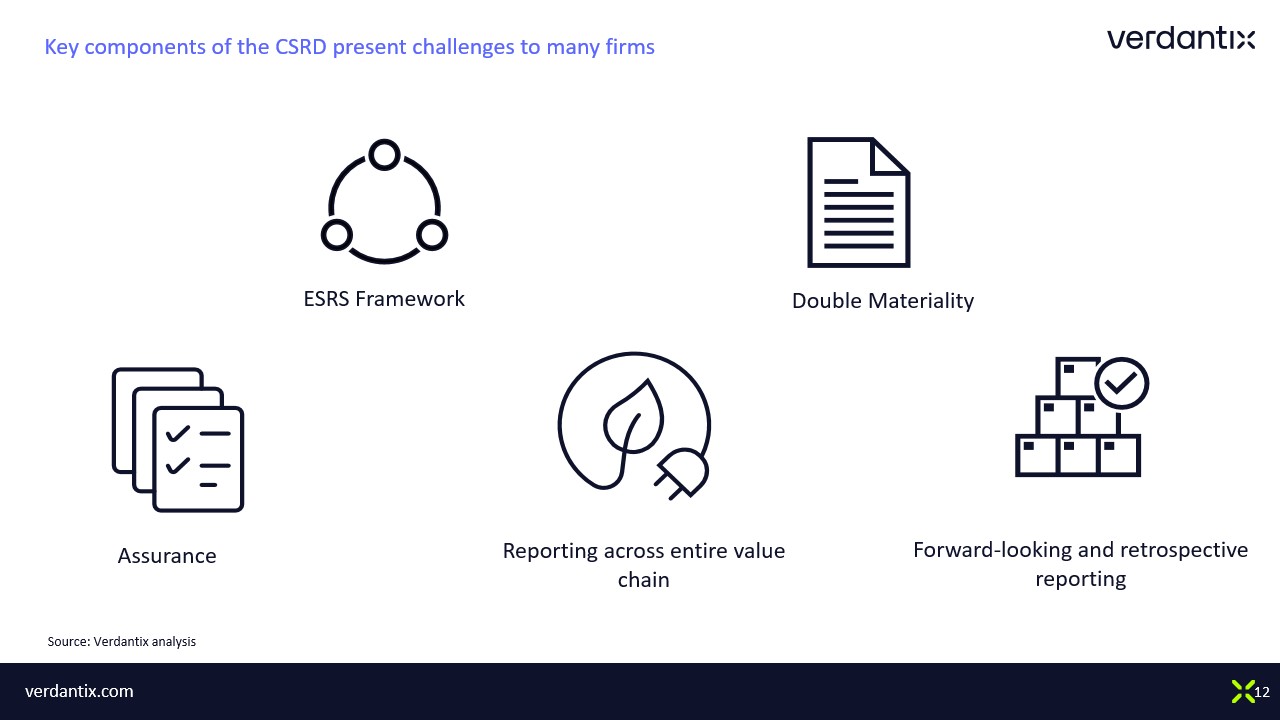
What really makes CSRD challenging are some of the key components, some of what really differentiates it from the NFRD.
- European Sustainability Reporting Standards, which require reporting across a variety of E, S and G topics.
- Double materiality, which is really taking both an inside-out and outside-in look at how different factors impact a company.
- Obtaining third party assurance of sustainability data, starting with limited assurance and then moving to reasonable assurance.
- Reporting across the entire value chain – looking at their upstream suppliers and downstream end users.
- Forward looking and retrospective reporting. In terms of emissions, this would be calculating emissions back to a base year for emissions calcs, for example. And forward-looking. Short (1-5), medium (5-10 yr) and long-term plan, as well as things like absolute GHG emission targets for 2030 and 2050.
- Overcoming these challenges necessitates effective data management systems and stakeholder engagement.
The CSRD establishes the European Sustainability Reporting Standards (ESRS) reporting framework

The ESRS framework is something that is established by the CSRD and serves as the foundation for sustainability reporting under the requirement. It establishes a common set of guidelines for firms to follow when disclosing their ESG performance.
There are 10 topical standards that firms need to report on ranging from things like climate change and pollution to their workforce and business conduct. There are also 2 cross cutting standards which are more general and don’t necessarily fall into one of those 3 pillars. This is the set of ESRS that currently has been passed, but there’s another second set that’s in development which focuses more on sector specific standards as well as simplified standards for some of those smaller and medium sized enterprises. Those are still under development with the European Commission.
In total, over a thousand data points firms may need to report to under the CSRD and not all of these points are going to be mandatory for every firm but a lot of them will be.
Double materiality— the cornerstone of the EU’s CSRD
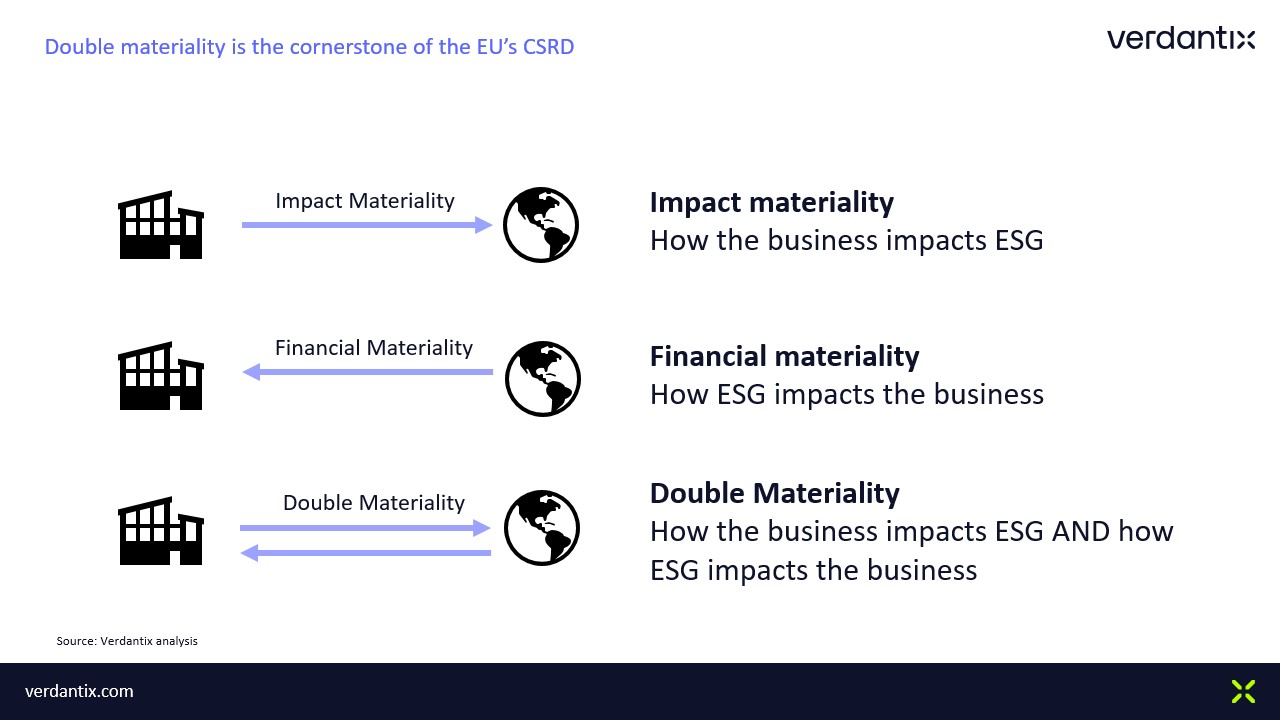
Double materiality is something that’s relatively unique to the CSRD, and it looks at both impact materiality which is how a business impacts its surrounding community. Think about things like how your wastewater discharge impacts the surrounding town, or how volunteerism affects your relationship with your community. This is more of an inside out viewpoint.
There’s also financial materiality, which is how external factors like floods or supply chain disruptions impact your business. For those familiar with some of the more voluntary reporting frameworks, the GRI is based on impact materiality and SASB is based on financial impact materiality.
Double materiality means firms are going to have to look at both impact and financial materiality and they’re going to have to report to the CSRD on all topics that are material from either a financial or an impact assessment point of view.
Investor-grade data—The first step to meet upcoming assurance requirements
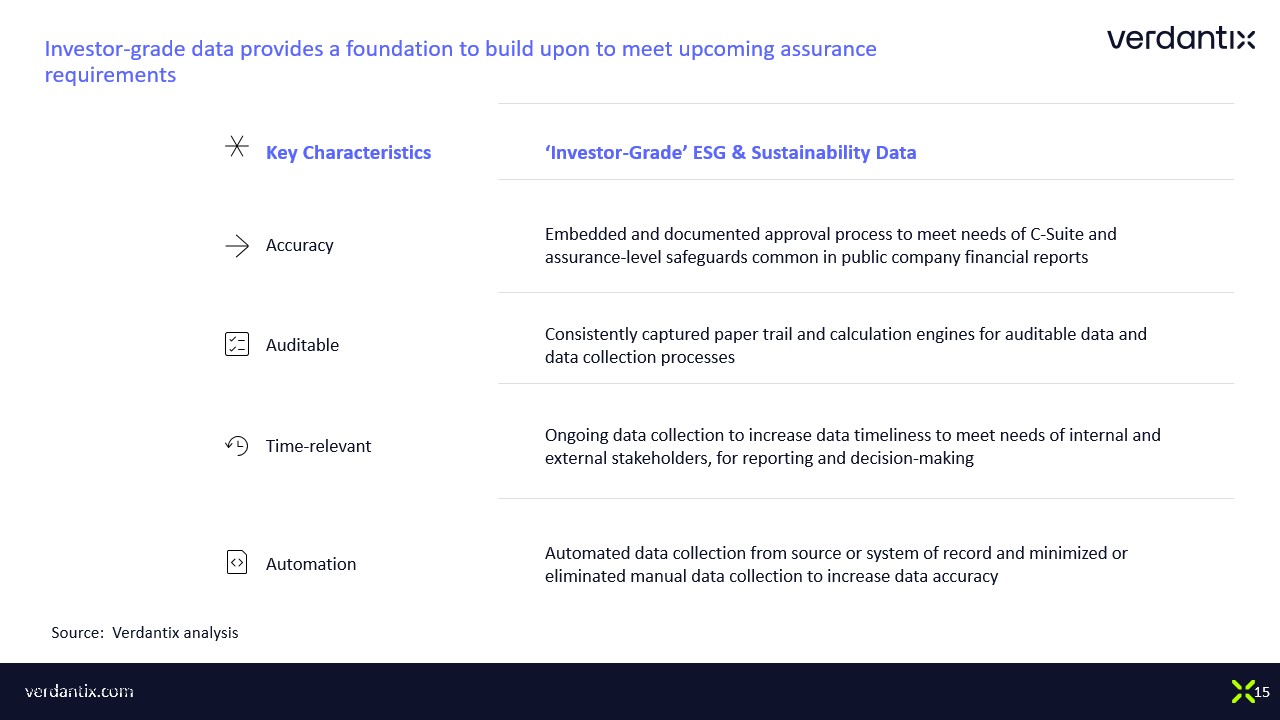
Disclosures across all those topics are going to have to be investor grade to meet the upcoming assurance requirements of the CSRD.
- Accurate – involves a documented approval process to help avoid misstatements
- Auditable – captures a paper trail for data traceability and transparency
- Time-relevant – enables ongoing data collection, as organisations will need to be able to provide data on request, rather than at one time in the year
- Automated – minimize manual data collection to avoid mistakes
Having investor-grade data is applicable for numerous regulations, not just the CSRD. Really is a best practice and it is a major step for most firms.
Most EU-based firms do not expect to have audit-quality supply chain emissions data in the short term
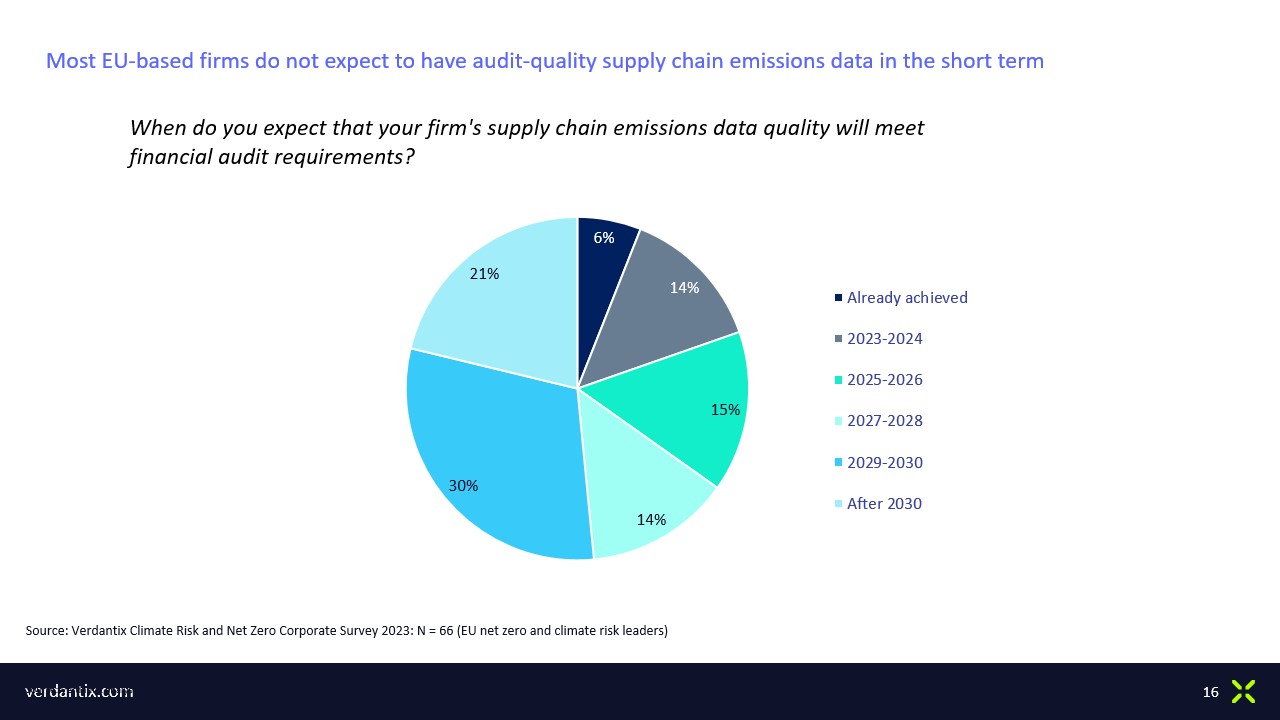
A survey done by Verdantix interviewed 350 heads of NZ asking if they think their supply chain emissions data quality will meet financial audit requirements.
- EU respondents: 20% believe that they will meet this standard by the end of 2024.
- Over half of them said they won’t meet these requirements until 2029, which may pose real concerns for them reporting in line with CSRD.
So what can 38,000+ firms do to get prepared for meeting this regulation?
One of the first steps that firms can take is develop an internal team to evaluate needs and what your current data collection processes look like. The CSRD requires so much data from so many different departments, so it’s important to have a team evaluate what is needed.
Another crucial step is looking for software to help comply with the investor grade requirements of the CSRD. It’s hard to manage a lot of the data that’s required with just spreadsheets alone.
If you are going to implement software, you first need to figure out what your needs are and then look for a software so solution to help you. The software evaluation process can take several months for firms that want to start getting prepared.
Market Readiness
73% see improving processes for mandatory ESG reporting as a top priority
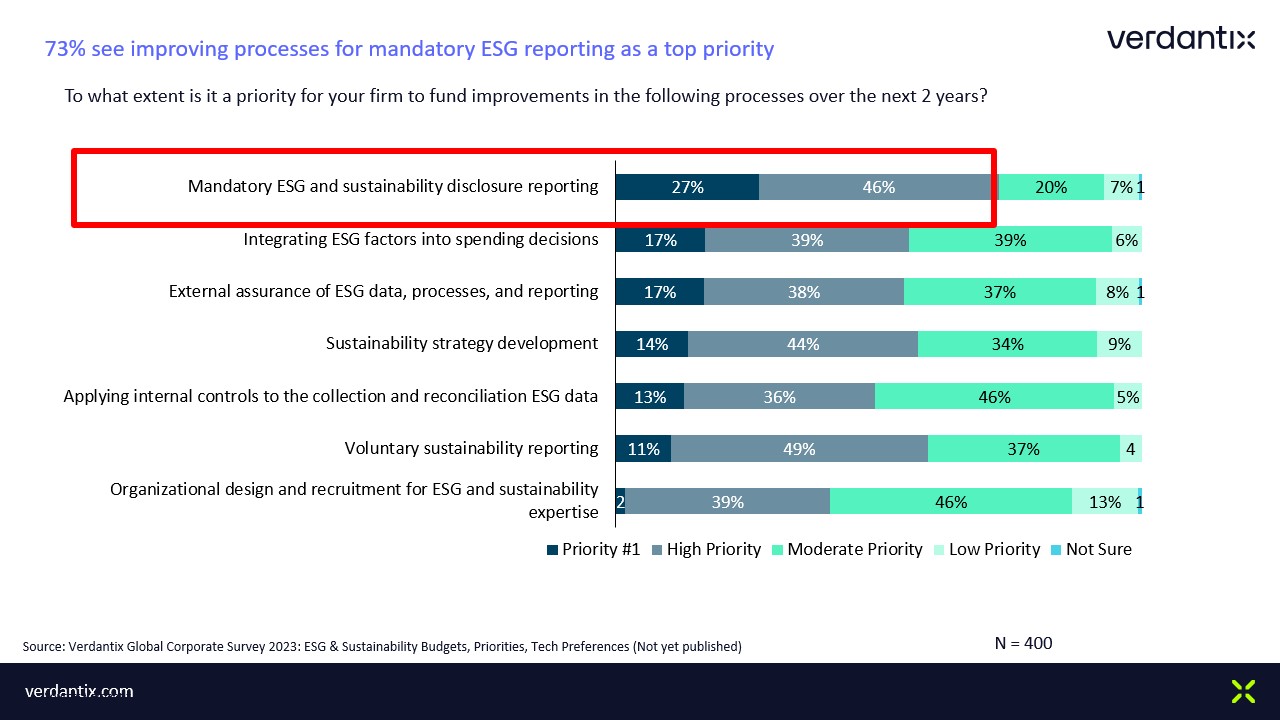
Verdantix interviewed 400 heads of sustainability from a variety of industries asking how much they’re prioritizing funding for certain sustainability improvements over the next 2 years. Results showed 73% of respondents see mandatory disclosure reporting as either a top priority or a high priority item, showing shifting customer needs and funding priorities to assist with disclosure reporting elements.
Impacts of Regulations for Your Firm
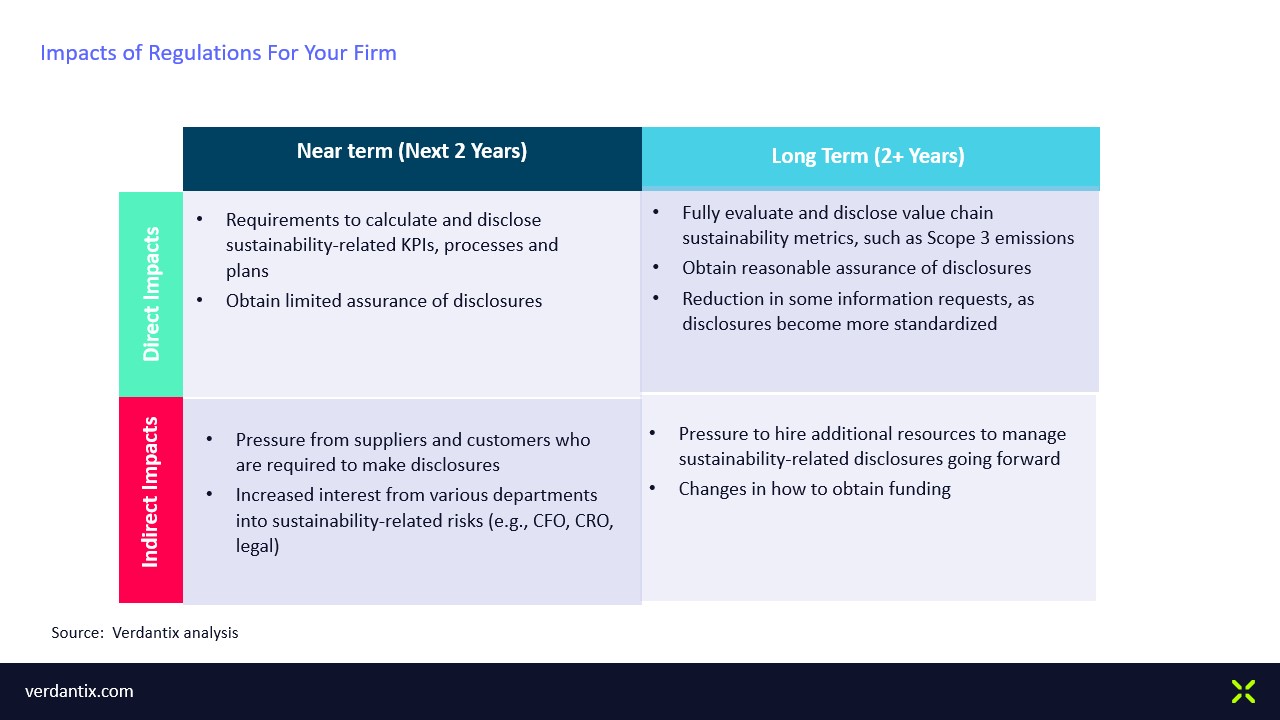
Part of the reason for this increase in spend and interest is because regulations will have direct and indirect impacts on pretty much all firms. So regardless of if or when you’ll be subject to the CSRD, it won’t be something you can ignore.
- Direct impacts – firms who are subject to the CSRD. Disclosing on a variety of sustainability related metrics, both for your firm and for your value chain, and obtaining assurance of these disclosures.
- Indirect impacts apply to firms who are not subject to the CSRD, and they are still going to feel the impacts of the regulation.
- Will face increasing pressure from suppliers and customers who are subject to these requirements and need to prepare disclosures for their value chain.
- They may also see changes in how they can obtain funding, such as by looking into sustainable bonds.
Getting ready for sustainability-related disclosures requires firm-wide collaboration
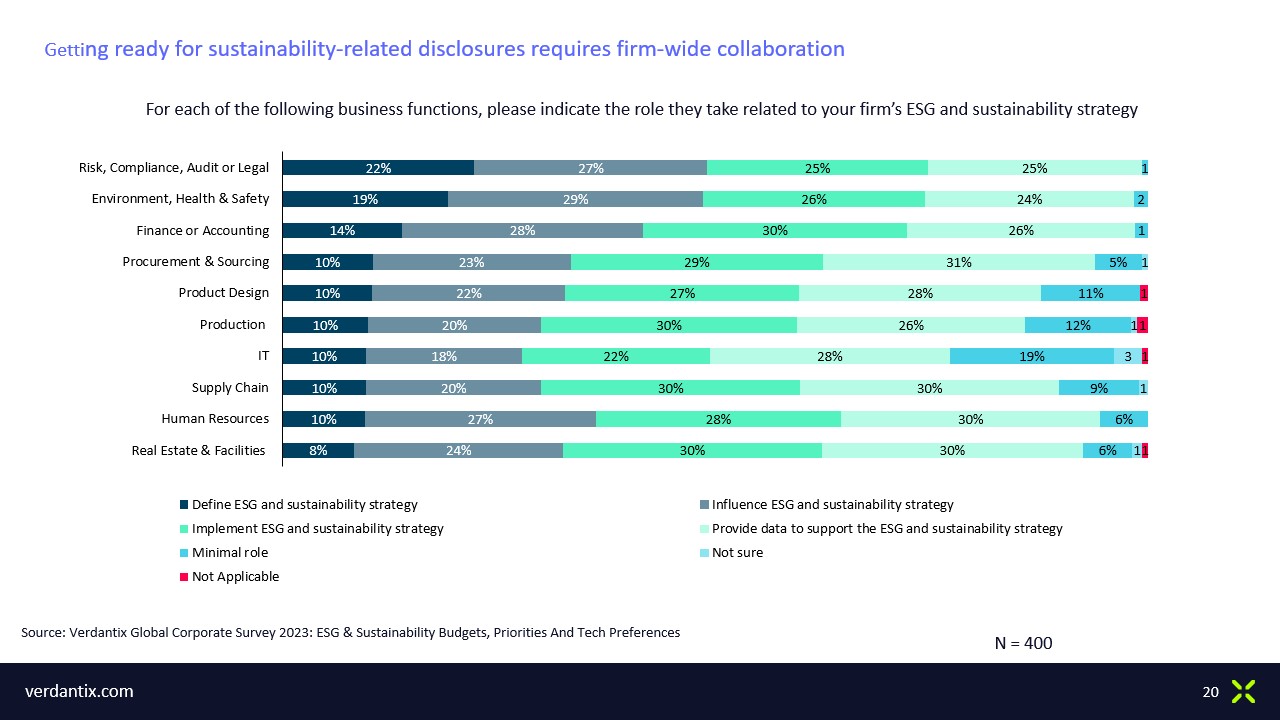
A survey done by Verdantix found getting the data that you need for the CSRD is more of a team support. And there’s a big challenge about how to gather that data and make sure it’s investor grade across all departments.
Market readiness: majority of firms still rely on manual data collection processes
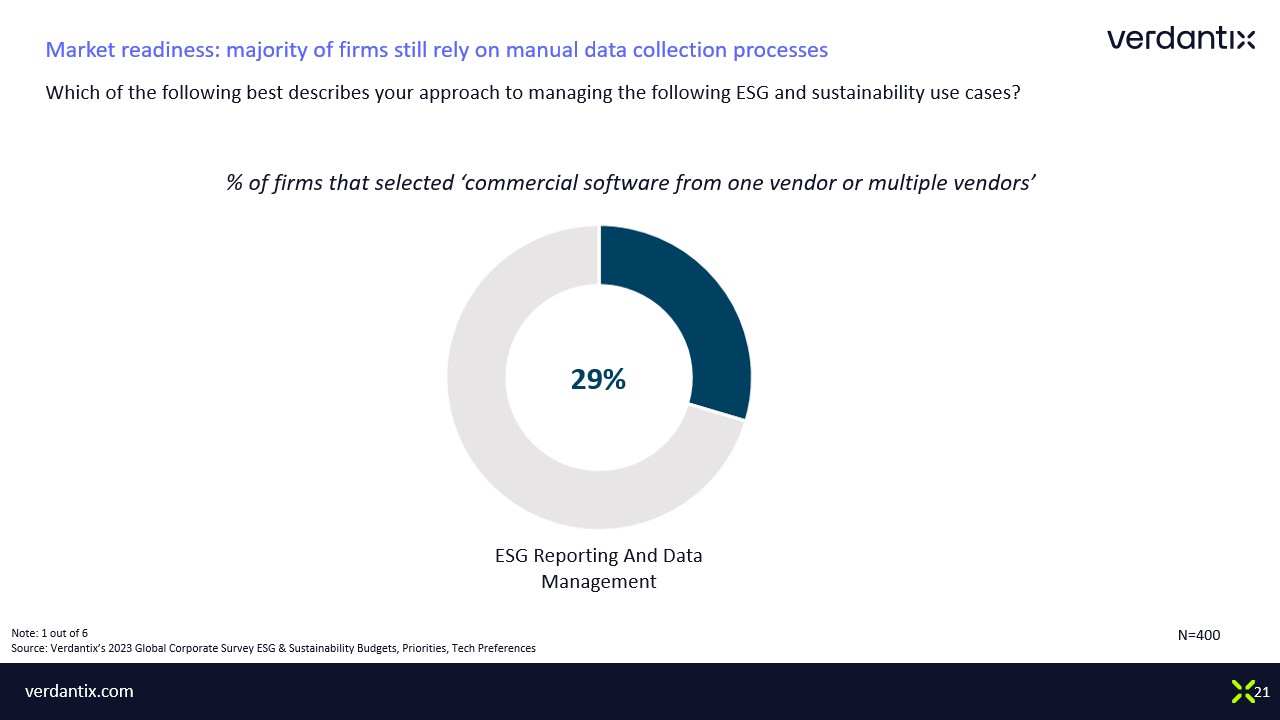
Another survey by Verdantix found teams heavily rely on spreadsheets to manage sustainability data, which is just not efficient for handling data from across departments.
Most corporations will need to turn to software to help them because spreadsheets aren’t automated, there’s no audit trail. There is also a high likelihood for human error. Using spreadsheets is especially difficult for firms with more complex value chains.
Facility-level emissions acquisition tools remain a high priority
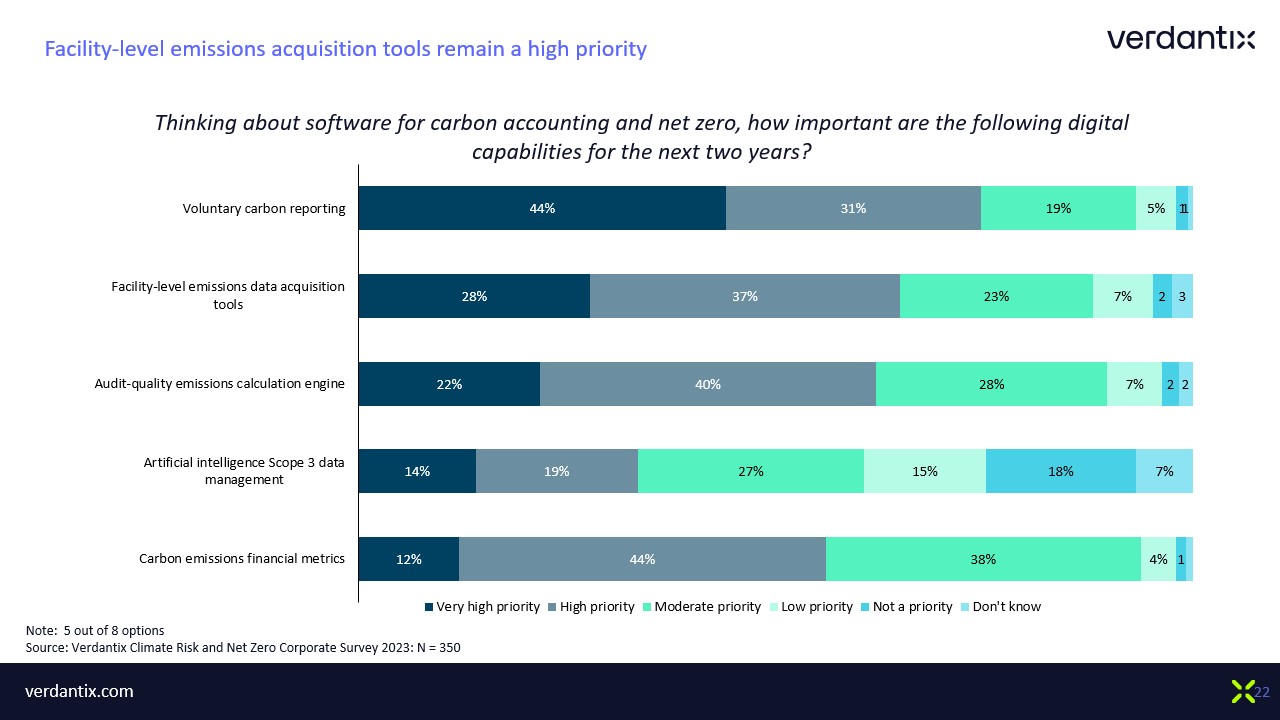
Verdantix asked companies how important certain digital capabilities are in the short term:
- 75% of respondents still think of voluntary reporting as a very high or high priority item.
- Almost two thirds of respondents saw facility-level emissions data acquisition tools, or tools focused on Scope 1 and 2 emissions as a high or very high priority.
- Only 1/3 of respondents said Scope 3 emissions was a top or very high priority.
Key Takeaways
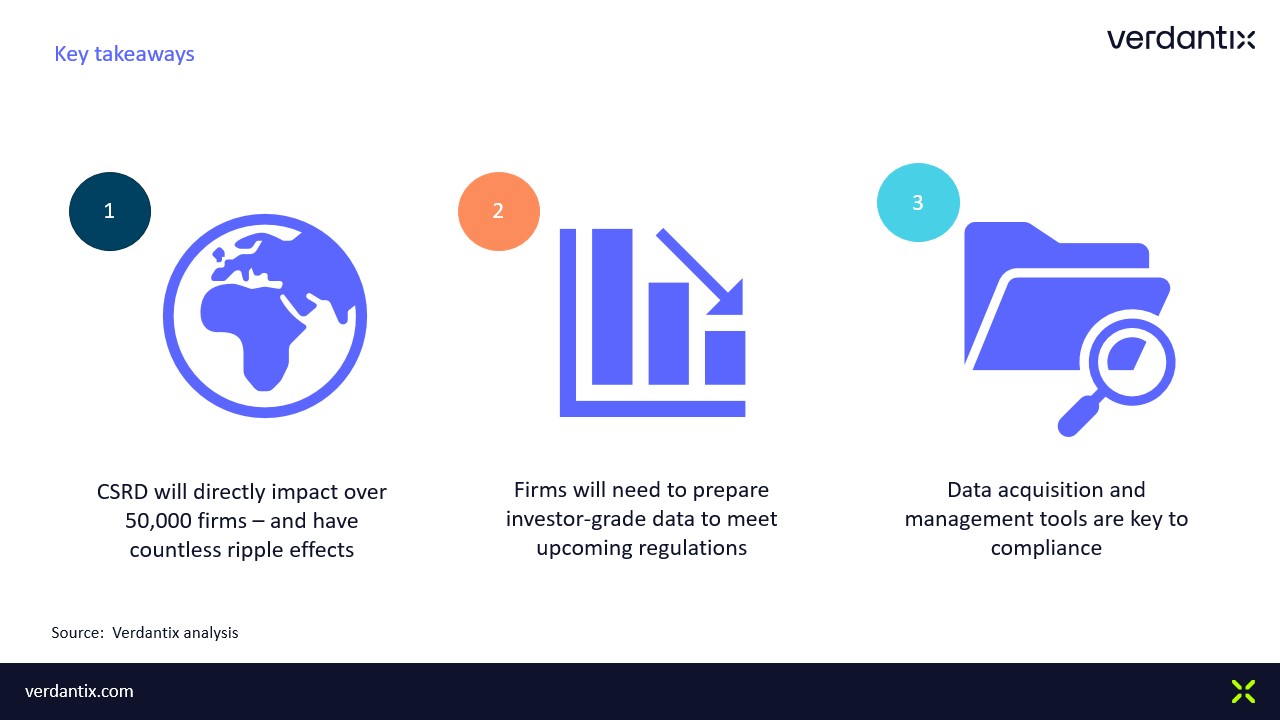
 Best-in-class portfolio-level energy and utility bill data management and reporting.
Best-in-class portfolio-level energy and utility bill data management and reporting.
 Real-time energy and sustainability analytics for high-performance, net-zero buildings.
Real-time energy and sustainability analytics for high-performance, net-zero buildings.
 A holistic view of financial-grade scope 1, 2, and 3 carbon emissions data across your entire business.
A holistic view of financial-grade scope 1, 2, and 3 carbon emissions data across your entire business.
 Energy and sustainability benchmarking compliance software designed for utilities.
Energy and sustainability benchmarking compliance software designed for utilities.


















